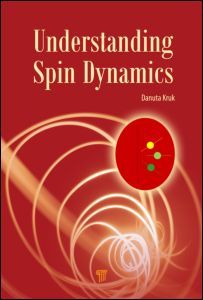Understanding Spin Dynamics
Auteur : Kruk Danuta

Experimental methods employing spin resonance effects (nuclear magnetic resonance and electron spin resonance) are broadly used in molecular science due to their unique potential to reveal mechanisms of molecular motion, structure, and interactions. The developed techniques bring together biologists investigating dynamics of proteins, material science researchers looking for better electrolytes, or nanotechnology scientists inquiring into dynamics of nano-objects. Nevertheless, one can profit from the rich source of information provided by spin resonance methods only when appropriate theoretical models are available. The obtained experimental results reflect intertwined quantum?mechanical and dynamical properties of molecular systems, and to interpret them one has to first understand the quantum?mechanical principles of the underlying processes.
This book concentrates on the theory of spin resonance phenomena and the relaxation theory, which have been discussed from first principles to introduce the reader to the language of quantum mechanics used to describe the behaviour of atomic nuclei and electrons. There is a long way from knowing complex formulae to apply them correctly to describe the studied system. The book shows through examples how symbols can be "replaced" in equations by using properties of real systems to formulate descriptions that link the quantities observed in spin resonance experiments with dynamics and structure of molecules.
Preface. Classical description of spin resonance. Introduction to spin relaxation. Formal theory of spin relaxation. Spin resonance lineshape analysis. Spin relaxation – a more general approach. Electron spin resonances of spins ½. Nuclear spin relaxation in paramagnetic liquids. Spin resonance beyond perturbation range. Dipolar relaxation and quadrupolar interactions. Effects of mutual spin interactions. Dynamic Nuclear Polarization. Anisotropic and Internal Dynamics. Index.
Danuta Kruk is associate professor at the Faculty of Mathematics and Computer Science, University of Warmia and Mazury in Olsztyn, Poland. She received her master’s and doctorate degrees in physics as well as attained her habilitation from the Jagiellonian University, Krakow, Poland. She has also been associated with Physical Chemistry Arrhenius Laboratory, Stockholm University, Sweden; Faculty of Physics, Technical University Darmstadt, Germany; and Experimentalphysik, University of Bayreuth, Germany. She is author of the book Theory of Evolution and Relaxation of Multi-Spin Systems. Her current research interests are theory of spin resonances and relaxation processes, dynamics of condensed matter including molecular and ionic liquids, polymers and biological macromolecules, spin relaxation in paramagnetic and superparamagnetic systems, transport phenomena and dynamics of electrolytes and nanofluids, and dynamical properties of solids.
Date de parution : 10-2015
15.2x22.9 cm
Disponible chez l'éditeur (délai d'approvisionnement : 15 jours).
Prix indicatif 94,48 €
Ajouter au panierThèmes d’Understanding Spin Dynamics :
Mots-clés :
Relaxation Rate; relaxation; Nitroxide Radicals; rates; Spin Relaxation; spectral; Dipole Dipole Coupling; density; Electron Spin Relaxation; dipole; Spin Lattice Relaxation Rate; coupling; Quadrupole Interaction; system; Lineshape Function; quantum; Electron Spin; number; Spin System; lattice; Esr Lineshape; Dipole Dipole Interaction; NMR Spectrum; Spectral Density; AIP Publishing; Correlation Time; Correlation Function; Pake Doublet; Quadrupole Coupling; Energy Level Structure; Principal Axis System; Esr Spectrum; Electron Spin Relaxation Rates; DNP; NMR Spectroscopy



